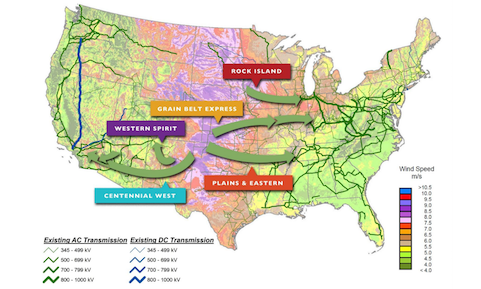A $2.2 billion dollar high voltage transmission line that would bring wind power from Kansas to Illinois and Indiana took an important step forward when it was approved Nov. 12 by the Illinois Commerce Commission.
Illinois joins Indiana and Kansas, which have already approved the 750-mile high voltage direct current transmission line. When finished, the line will carry 4,000 megawatts of wind-generated power to major load centers in the Midwest and the East Coast, enough to power 720,000 homes.


|
| Clean Line Energy’s five high-voltage transmission line projects will carry power from the windiest regions of the U.S. in the Midwest to the large population centers on the coasts. |
Of the states along the route, only Missouri rejected the proposal on 3-2 vote last summer at the state public service commission.
“This is an important accomplishment and I believe it puts the project in a strong position to appeal the Missouri vote,” said Springfield, Ill., Local 51 Business Manager James Bates.
Grain Belt Express is one of five projects in development by Clean Lines, a private, Texas-based company. Like the Grain Belt Express, Western Spirit, Rock Island, Centennial West and Plains & Eastern projects are transmission lines that will carry energy produced in America’s windiest states –Kansas, Oklahoma, Nevada and Iowa—to major load centers on the coasts.
Rank-and-file, local leadership and international representatives were all active participants throughout the five-year, multistate, review process. In the weeks before the vote, the IBEW ran an ad produced by the Media Department in Missouri and Illinois that made the case for approval.
“The IBEW is looking forward to working with the contractors that the company will hire to build the Clean Lines projects when they are finally approved,” said Business Development International Representative John Bourne.
Various locals of the IBEW have already signed Project labor agreements on two other major transmission line projects – Transwest Express and Zephyr – which will carry wind-generated electricity from Wyoming to Southern California.
The next step for the project is unclear. The Missouri Public Service Commission rejected a request for a rehearing a month after the July no vote on the permit.
“The Public Service Commission, in their order of denial, allowed the company to come back when new evidence allows. So is Illinois’ approval new evidence?” Bourne said. “How about the new Clean Power Plan handed down by EPA which mandates more clean/green energy?”
 |
| High voltage direct current lines need a much smaller footprint than alternating current lines. |
When Arkansas regulators rejected their state’s part of the Plains and Eastern transmission line, Clean Lines switched to a slower and more expensive federal approval and siting process that could bypass state-level rejections.
The results for Plains and Eastern have been positive. The Department of Energy issued a positive environmental impact statement for the project, and Clean Lines is now waiting for a federal ruling that would green light this project. Nevertheless, Bourne said, switching strategies to go around the Missouri regulators is far from straightforward.
“I think I was told that it would take several years and millions of dollars to pursue the federal route, so I think that would be a last resort,” Bourne said.
And it might not be necessary. Public pressure on the Missouri commission has also been building inside Missouri since the Illinois vote. The St. Louis Post-Dispatch ran an editorial urging approval.
“In the short term, it’s easy to understand why farmers may not want wind turbines whipping up the air over their land and changing life as they know it,” the editors wrote. “But if rural landowners in Missouri don’t give a little and embrace ways to save the Earth from global warming, more than farming as they know it could be at stake.”
Even if the Missouri commission reversed its vote tomorrow, Bourne acknowledged that it will be some time before IBEW members are cashing paychecks from Clean Lines.
“This job is important to our members not just for the transmission lines, but for all the wind turbines, substations and the DC-to-AC converters that will feed the lines,” Bourne said. “It may take a while, but when we finally start putting poles in the ground, it will have been worth the work.”